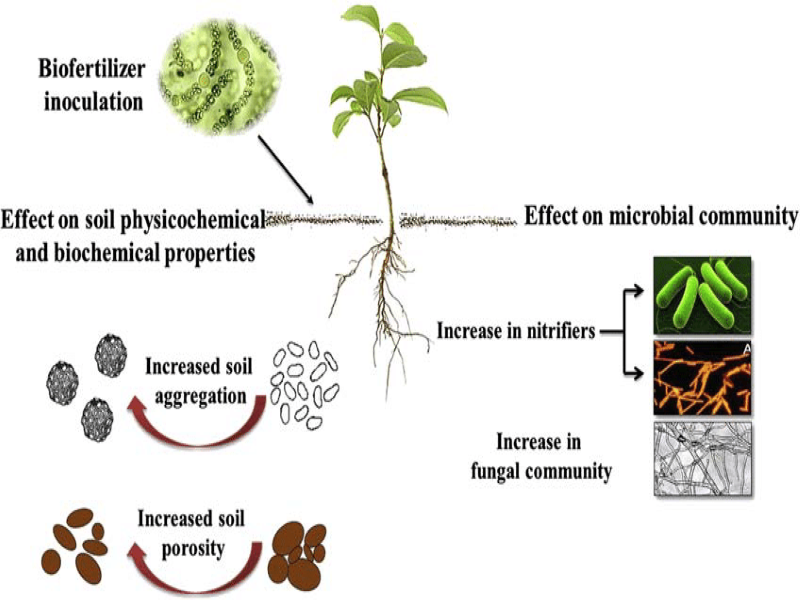
The use of biofertilisers is quite important while practising the concepts of integrated plant nutrient management and organic farming. Some of the commonly used biofertilisers in Kerala are as follows.
- Rhizobium (Bradyrhizobium and Azorhizobium)
It induces better root nodulation and stem nodulation (Azorhizobium) in inoculated plants and thereby brings down the requirement of nitrogen fertilizer for the cultivation of pulses, oilseeds and legume green manures. Commercially it is available as carrier-based inoculums. Method of application is seed treatment.
- Azotobacter
Suitable only for upland crops like vegetables, tapioca, plantation and orchard crops. It is available as carrier-based inoculum. It fixes N about 15-20 kg/ha under ideal upland conditions and thereby reduces the requirement of nitrogen fertilizers by 10-20 per cent. Methods of application are seed treatment, seedling dip and direct soil application.
- Azospirillum
It is suitable for both upland and wetland conditions and is available as carrier-based inoculum. It fixes N about 20-25 kg per ha under ideal conditions thereby effecting a reduction of 25 per cent in the quantity of N fertilizers required. Treatment with Azospirillum also induces better root formation in inoculated plants. Hence this biofertilizer is also recommended for root induction in polybag-raised seedlings of plantation and orchard crops and also for vegetable crops. The isolates of Azospirillum brasilense strains AZR 15 and AZR 37 from Kuttanad soils are highly effective for rice, vegetables and nursery plants. The strains AZ 1 and AZ 2 are effective in vegetable and nursery plants.
Method of application
Seed treatment: For treating 5-10 kg seeds, 500 g culture is required. Moisten the seeds by sprinkling water or rice-gruel water. Take 500 g culture in a plastic tray/basin, add moistened seeds, mix well and dry in shade for 30 minutes. This may be sown immediately.
Seedling root dip (for transplanted crops): Slurry of the culture is prepared by mixing 500 g culture with 50 ml of water and the roots are dipped in the slurry for 15-20 minutes before transplanting.
Soil application: Mix the culture with FYM or compost in the ratio 1:25 and apply directly in the soil.

Inoculation for paddy
Mix 2 kg of culture in 60 litres of water and soak the seeds required for 1 ha (60 kg) for 24 hours before sowing. At the time of transplanting, dip the roots of seedlings for 15-20 minutes in the culture slurry prepared by mixing 2 kg inoculum with 40 litres of water. This slurry can be used for treating seedlings required for 1 ha. Another 2 kg culture may be applied to the field along with FYM or compost.
- Blue-green algae(BGA)
Mainly recommended for wetland rice cultivation. However, the use of this biofertilizer is not feasible in acidic soils with a pH below 6.0. It is available as carrier-based inoculum and it fixes N about 25-30 kg/ha under ideal conditions.
Method of application: Direct broadcasting in the rice fields @ 10 kg/ha one week after transplanting the seedlings.
- Azolla
It is suitable for wetland rice cultivation. The required quantity of Azolla will have to be raised in the farmers' field itself. Fixes N about 25 to 30 kg/ha.
Method of application: Apply fresh Azolla @ 10 t/ha before transplanting the rice seedlings at the time of ploughing.
- Phosphate solubilising bacteria and fungi
Recommended mainly for upland crops raised in neutral and slightly alkaline soils. Available as carrier-based inoculum. Enables the efficient utilization of cheaper sources of phosphatic fertilizers such as rock phosphate by crop plants in neutral and alkaline soils.
Application techniques of biofertilisers
- Seed treatment
Five hundred grams of commercially available inoculum will be required for treatment of seeds for the one-hectare area. For this, a thick slurry of the carrier-based inoculum is initially prepared by mixing 500 g of the inoculum in 1.25 litre of water. The stickiness of the biofertilizer on seed surface can be significantly improved by using 10% jaggery solution or 5% sugar solution supplemented with 40% boiled and cooled gum arabic solution or rice-gruel water. The required quantity of seed material is then gently mixed with this slurry by taking care not to damage the seed coat. The treated seeds are spread evenly over a gunny bag and dried in shade and sown immediately in moist soil. Under no circumstances, the treated seeds are exposed to direct sunlight for a longer period of time since the UV rays of solar radiation will reduce significantly the population of inoculated bacteria on the seed surface.

- Seedling treatment
This method of application is mainly recommended for transplanted crops. In this procedure, the roots of seedlings to be transplanted are dipped in loose water slurry of the biofertilizer (500 g in 2.5 litres of water) for 20 minutes, prior to transplanting.
- Soil application
Soil application is generally recommended for all types of biofertilisers except Rhizobium, Bradyrhizobium and Azorhizobium. The method is to apply the biofertilizer after mixing with dried FYM, compost or vermicompost @ 1:25. For crops of six-month duration, the recommended dose is 1-2 kg/ha. This can be increased to 2-4 kg/ha for crops of more than six-month duration. For perennial crops, 10 to 25 g of the biofertilizer is to be applied in the root zone during the first year and 25 to 50 g during subsequent years. This can be done at the time of sowing, transplanting or during inter cultivation.
Factors influencing the efficient use of biofertilisers
- Use the adequate quantity of organic manure (as per the recommendation for each crop) along with biofertiliser application. This is essential to ensure better survival, growth and activity of the introduced microbial inoculums in acidic soils.
- Liming is essential if the soil pH is below 6.0. In moderately acidic soils, the application of lime @ 250 kg/ha is recommended along with biofertilizer treatment.
- Irrigation is essential during summer months after biofertilizer application to ensure the survival of the introduced microbial inoculum in the soil.
- Since biofertilisers can supplement only a part of the nitrogen requirement of the inoculated plant, a low dose of nitrogen and full doses of phosphorus and potassium as per the recommendation may be applied. This is essential to ensure better plant growth and yield. Similarly, in the case of P biofertilisers, the full doses of nitrogen and potassium should be applied. However, there should be a gap of at least one week between biofertilizer and chemical fertilizer applications.
- Use only biofertilisers, which are manufactured as per the quality parameters prescribed by the Bureau of Indian Standards. In the case of bacterial biofertilisers, the prescribed standard is that in the final product, the population of the desired bacterium should not be less than ten million per gram of the carrier material and there should not be any contamination with other microorganisms when examined at 1:100000 dilution. Further, it should have a shelf life of at least six months.
- The commercially available biofertiliser should always be used before the expiry date marked on the culture packet.
- Topdressing with superphosphate 25 kg/ha 10 days after inoculation of BGA will enhance its growth under field conditions.
- Since the occurrence of green algae in rice field can affect the normal growth and proliferation of BGA, the population of green
algae should be controlled initially by applying copper sulphate @ 4 kg/ha.
- In moderately acidic soils of pH around 6.5, root nodulation by Rhizobium and Bradyrhizobium can be improved by pelleting with finely powdered calcium carbonate. (See recommendation under cowpea)
- Application of P2O5 @ 1 kg/ha is recommended once in 4 days in P2O5 deficient soils to ensure good growth of Azolla. The development of a reddish-purple colour in Azolla is a typical symptom of P2O5 deficiency.
- Since a floating population of Azolla can release its bound nutrients only during decay in the soil, it is essential to incorporate Azolla in the soil prior to the transplanting of rice seedlings.
(Source- Kerala Government)










